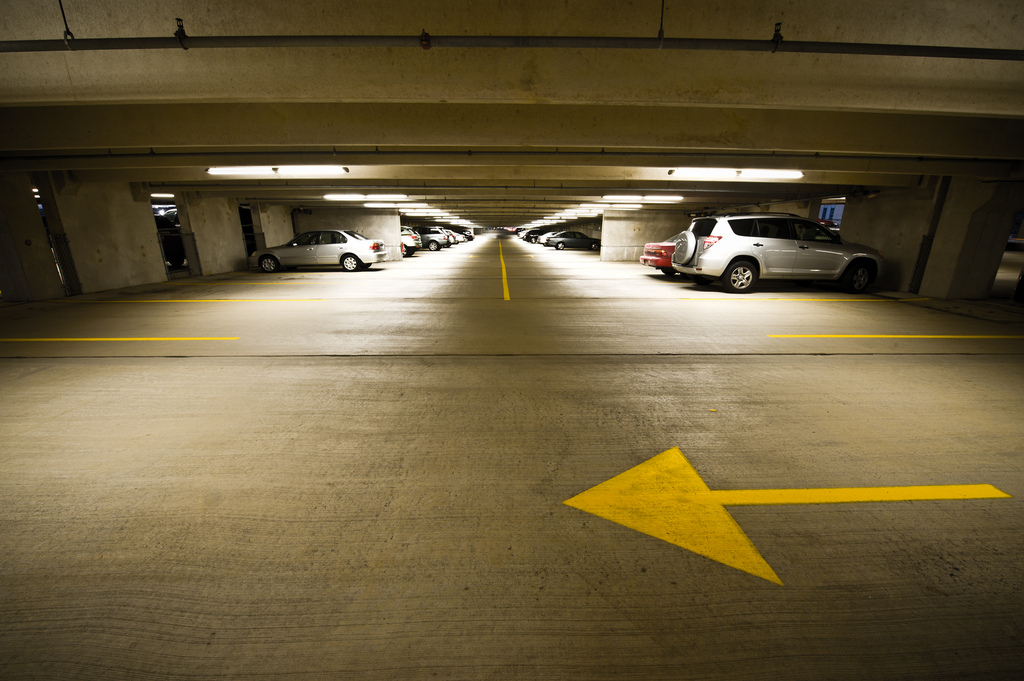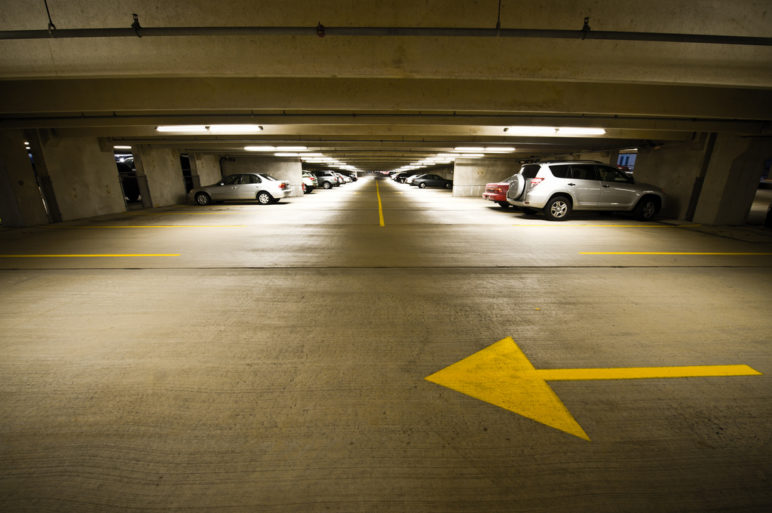If I were Emperor of Cascadia, I would ban all rules that require new buildings to provide off-street parking spaces. The case against mandating parking couldn’t be stronger: parking makes housing more expensive; it reinforces reliance on carbon-spewing cars; it hinders travel by walking, biking, and transit; and it makes cities ugly.
Not being the emperor, though, I’ll take what I can get, and the set of parking reforms Seattle planners recently proposed has two standout offerings. The first is way in the weeds. It would fix a technical glitch in the city’s off-street parking exemption for housing located near transit.
The second taps into a big idea: the sharing economy. The gist of it: let’s share the parking we already have so we can stop building too much of it. Studies have shown that apartment buildings in Seattle have a lot of excess parking—35 percent extra unused stalls on average. The city’s proposal would undo rules that prohibit that underutilized parking from being sold to people who don’t reside in the same building.
Let’s take a closer look at these two proposed policy moves that would help Seattle evolve into a more walkable, carbon-efficient city welcoming to all.
Getting clear about reduced parking requirements near transit
Because outright elimination of off-street parking requirements is politically unthinkable in most Cascadian cities today, many reformers are pursuing an incremental approach. Seattle, like numerous other cities, reduces parking mandates for housing that has good transit access. For new housing near frequent transit, Seattle waives or halves off-street parking mandates, depending on the type of neighborhood. “Near” means one-quarter mile walking distance. “Frequent” means that the time between arrival of transit vehicles—the headway—is 15 minutes or less during a large portion of the day.
Here’s the problem: Seattle’s current definition of frequent leaves no wiggle room for the small variations caused by unpredictable factors like bad traffic. So even though a bus line may be scheduled for 15-minute headways, according to the letter of the law, it doesn’t qualify if buses show up late from time to time. And sure enough, as I described in a previous article, a neighborhood group recently exploited this overly strict definition to block construction of an apartment building with no off-street parking. The ill-defined rule also helped kill microhousing construction.
By allowing reasonable wiggle room in actual headways, Seattle’s proposed redefinition would meet the original intent of the exemption, and it would allow builders to forgo parking without putting their projects at risk of time consuming and costly appeals. It’s a good move for housing affordability.
What’s disappointing, however, is that Seattle has taken so long to make such a simple fix to its land use code. City planners have been aware of the flaw since 2014. Correcting the rule was one of the 65 recommendations in Seattle’s 2015 Housing Affordability and Livability Agenda (see Prk.3). Three years to update a few lines of city code? The Seattle city council could have rapidly enacted “emergency legislation” to implement revisions, as it has done in the past, ironically, to stop homebuilding.
The road to shared parking
The story of Seattle’s of recent shared parking endeavors began in 2011 at King County Metro, the agency that runs the region’s buses. Metro planners won a US Federal Highway Administration grant to explore tapping into excess parking in apartment buildings for park-and-ride patrons. The agency was banking that sharing an existing parking resource to meet park-and-ride demands would be cheaper than building new garages.
The first step in Metro’s project—dubbed “Right Size Parking”—was to determine how much unused parking is out there. Metro planners counted empty parking stalls in more than 200 apartment buildings throughout King County. They found that on average, for every one stall occupied, 0.4 stalls sat empty. That is, parking was overbuilt by a whopping 40 percent. In Seattle alone, the parking surplus was a little lower at 35 percent. They then used their data to build a statistical model that estimates parking demand at any location in the County.
The next question was: would local city rules allow owners to share their parking with people who were not residents of the building? Here the findings were not as encouraging, as most cities had regulatory barriers in one form or another, including Seattle. The Metro team worked with Seattle planners to craft new rules for shared parking that landed in the city’s current proposal.
Finally, assuming it was legal, could selling off unused parking be profitable enough for property owners to bother? To find out, Metro planners engaged developers, apartment owners, parking operators and urban planners in cities throughout the county, and proceeded to launch a pilot program in partnership with Diamond Parking. The partnership is currently operating thirteen locations as park-and-rides. The four sites in Seattle are commercial lots because regulations don’t allow sharing of residential parking—yet.
Sharing parking resources is a win for affordability and sustainability
While Seattle’s current efforts to eliminate barriers to shared parking may have been catalyzed by the King County Metro’s park-and-ride ambitions, the city stands to gain much more. For one, using existing parking more efficiently helps recover the sunk costs of oversupplied parking. For another, underutilized parking can absorb new parking demand, so that future buildings can be constructed with fewer stalls. Developers can build confidently, knowing that tenants can find parking nearby. Municipalities can forgo huge parking structures. To summarize the benefits:
- Cheaper and more abundant housing (parking stalls take up space and cost upwards of $40,000)
- Improved urban livability through better urban design and architecture
- Reduced car use and associated climate pollution
- More walking, biking, and transit use
One concern about allowing shared parking is that it could backfire: developers might build extra parking to sell to people not residing in their building. Seattle’s proposal would address that concern by placing a 145-stall cap on shared parking in any one development. It’s an improbable scenario anyway, because in urban areas parking costs so much to construct that it’s still likely to be a money loser for developers, even counting the extra revenue from sharing.
The only complaint I have about Seattle’s shared parking proposal is that it won’t be allowed throughout the city. Citing concerns over concentrated traffic, commuting, and mix of uses, planners excluded the neighborhoods of South Lake Union and Uptown, was well as the majority of downtown. It’s possible that shared parking could initially attract more car commuters, but over the long term the benefits of shared parking would outweigh any near term setbacks.
A transparent, efficient market for parking will minimize the toxic excess
In many cities parking regulations create a dysfunctional market in which parking is oversupplied yet inaccessible to consumers. Correcting that market distortion is a critical piece of the puzzle for ending the urban scourge of too much parking. Allowing shared parking is one key step, because it opens underutilized stalls and puts a price on them.
Parking regulations create a dysfunctional market in which parking is oversupplied yet inaccessible to consumers.
The primary market distorter, of course, is minimum requirements for off-street parking that force developers to build more than they need. And of course the simple fix is to eliminate those minimums (my first decree as Emperor of Cascadia!). That wouldn’t halt the construction of new parking—many developers would opt to include parking anyway, as some do today in parts of Seattle where no parking is required. But at least it would end a government-enforced glut of parking.
Another factor that distorts parking markets is the practice of lumping together apartment rent and parking rent, known as “bundling.” When landlords bundle, tenants usually pay for parking whether they use it or not, and they often have no way of knowing how much of their rent goes to parking versus housing. People can’t make rational purchasing choices when the price is not transparent. The remedy is to “unbundle” the two rents, a solution that also happens to be a necessary condition for shared parking. Seattle’s proposed parking reforms include a stipulation for unbundling in new buildings with 10 or more units, and for new leases in buildings with 10,000 square feet or more of floor space. It’s a smart policy, although in Seattle the new apartment market has already begun shifting to unbundling on its own.
The final piece of the puzzle for a functional parking market is a means to efficiently connect parkers with available spaces and collect their money. There’s an app for that! Many of them, actually. Shared parking distributes stalls in numerous locations, and parking apps can give real-time info on what’s available and how to find it. Think Airbnb for parking. Anyone who has an empty space could add it to the pool. In the same way that Airbnb enables efficient utilization of a city’s bedrooms, an app-based shared parking system would help get the most out of the parking we already have. And that would help break the vicious circle of building more than we need.
Build less, share more, build less, share more…
As growing Cascadian cities evolve away from car dependence, the need for parking will decline. More people travel by transit, biking, and walking. Priority number one is to do away with outdated rules that hold back that beneficial evolution by making it illegal to not build too much parking. That’s why Seattle’s proposal to fix its parking exemption for housing near transit, though seemingly minor, is an urgent improvement. The parking beast can also be tamed by fully utilizing the parking we already have, which is the intent of Seattle’s proposal to remove regulatory barriers to shared parking. Counterintuitively, deregulating parking, because it nurtures an undistorted, efficient market, can actually help minimize parking and the damage it does.
Disclosure: In my prior job at VIA Architecture I worked with King County Metro on the Right Size Parking project.
The city is accepting comments on the the current draft of the parking proposal through October 5 (today!). Send comments to Gordon Clowers, SDCI Senior Planner, at gordon.clowers @seattle.gov.












Eric Darwin
There’s an app for that? To find “available” and “unused” parking spaces? Sounds good, but only at first. What will really happen is that people will rent out their unused driveways. Then they will widen them to get the additional parking space. Eventually, backyard parking will expand to fill the whole lot. And since housing is in short supply, the landlords will rent the houses or apts without parking and rent it out to nearby offices and commercial tenants who will pay much more than residential tenants.
I am afraid that app is an app for paving over more of the as-yet-unpaved space in our neighbourhoods and is another blow against backyard trees surviving.
Eric Darwin, WestSideAction.com
Michael J Critelli
I could not agree more with your comments about parking. I would also note that, at a time when Uber, Lyft and other transportation network services are available in virtually every major city, the need to have fixed route public transit available every 15 minutes becomes less pressing. We need to expand group transit options and reduce the amount of space dedicated to parking.
I would also note that parking lots or garages do not maximize the revenues yield for a municipality or a developer. The expansion of cafes into sidewalks and streets creates more sales tax revenue than the lost revenue from the elimination of a parking space.
A.
I agree with you — expanding transit and reducing parking space is necessary!
A.
I love this article. We need to get rid of parking minimums, asap! In my building on Capitol Hill 15/45 parking stalls are unused, there’s always street parking available w/in a few blocks, and several bus lines that go by. People just need to start shifting their habits; transit is great and it’s not the end of the world if you have to park a couple blocks from home.